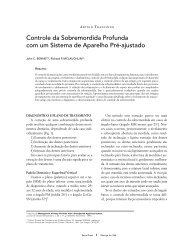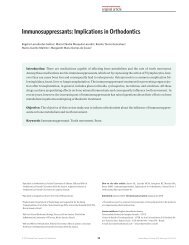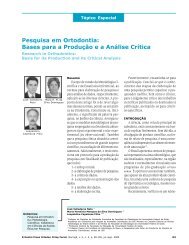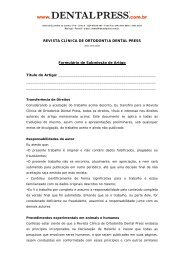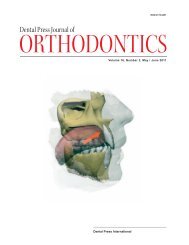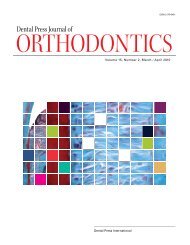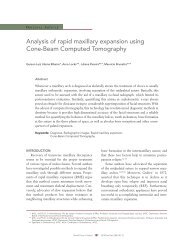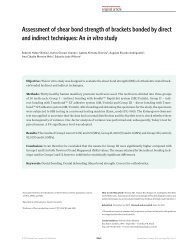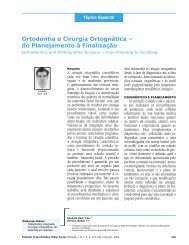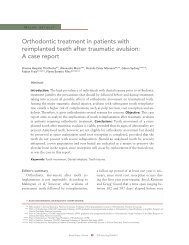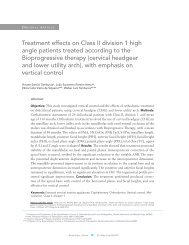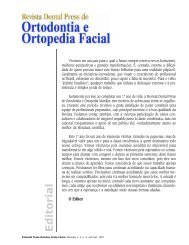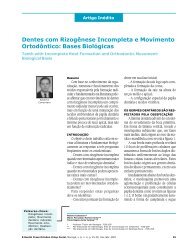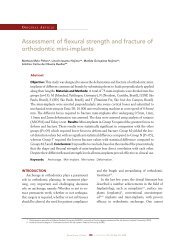Dental Press
Dental Press
Dental Press
You also want an ePaper? Increase the reach of your titles
YUMPU automatically turns print PDFs into web optimized ePapers that Google loves.
original articleThe persistence of different calcium hydroxide pastemedications in root canals: an SEM studyHélio Katsuya Onoda, DDS 1Gerson Hiroshi Yoshinari, MSc, PhD 2Key Fabiano Souza Pereira, MSc, PhD 2Ângela Antonia Sanches Tardivo Delben, MSc, PhD 3Paulo Zárate, MSc, PhD 4Danilo Mathias Zanello Guerisoli, MSc, PhD 2AbstractIntroduction: There is a possibility of intracanal medicationremain in the root canal even after its removal priorto obturation. The present study aims to evaluate underscanning electron microscopy the persistence of residuesin the root canal from calcium hydroxide medicationsprepared with different vehicles. Methods: Thirtysixbovine incisors had their crowns removed, the rootcanals prepared and were assigned randomly to six differentexperimental groups, according to the intracanalmedication used. Group I (control) received no intracanalmedication, whereas root canals of Group II were filledwith P.A. calcium hydroxide. Group III received a mixtureof Ca(OH) 2and saline solution, in Group IV glycerin wasused as vehicle, and Groups V and VI received Ca(OH) 2mixed with propylene glycol or polyethylene glycol 400,respectively. After one week, medication was removed,roots were split and the canals observed under the scanningelectron microscope. Representative photomicrographsof the apical third of each experimental groupwere observed and analyzed quantitatively by means ofa grid, with results expressed in percentage of canal wallscovered by debris. Results: Statistical analysis (one-wayANOVA and Tukey’s post hoc test, α=0.05) revealedsignificant differences between groups, indicating higheramounts of Ca(OH) 2residues in the canals where propyleneglycol or polyethylene glycol were used as vehicles.The dentinal walls of the canals that received pure P.A.calcium hydroxide or its association to glycerin presentedamounts of debris similar to the control group. Conclusions:Ca(OH) 2P.A. based medications or its associationto glycerin allows an easier removal from the root canal.Keywords: Calcium hydroxide. Intracanal medication. Vehicles.Onoda HK, Yoshinari GH, Pereira KFS, Delben AAST, Zárate P, Guerisoli DMZ. The persistence of different calcium hydroxide paste medications in root canals: an SEMstudy. <strong>Dental</strong> <strong>Press</strong> Endod. 2011 apr-june;1(1):77-81.1Post-Graduation student, Federal University of Mato Grosso do Sul, Program for Health andDevelopment in the Midwest Region.2Discipline of Endodontics, Federal University of Mato Grosso do Sul.3Department of Physics, Federal University of Mato Grosso do Sul.4Discipline of Cariology, Federal University of Mato Grosso do Sul.Received: January 2011 / Accepted: February 2011Correspondence address: Danilo M. Zanello GuerisoliAv. Senador Filinto Müller, s/n, Campo Grande/MS, BrazilZip code: 79.076-000E-mail: danilo.zanello@uol.com.br© 2011 <strong>Dental</strong> <strong>Press</strong> Endodontics 77<strong>Dental</strong> <strong>Press</strong> Endod. 2011 apr-june;1(1):77-81



